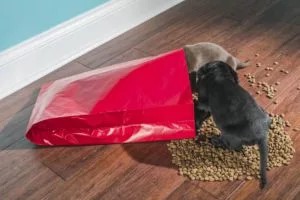Is your puppy exhibiting food-guarding behavior? Food aggression, the act of protecting food with snarls, growls, or even bites, is a common issue in puppies. While it’s natural for dogs to be protective of resources, this behavior needs to be addressed early to prevent escalation. You’re not alone in this challenge. This guide provides actionable strategies to help you understand and manage food aggression in your puppy.
Understanding Food Aggression in Puppies
Food aggression stems from a puppy’s instinct to survive. They might feel the need to guard their food if they perceive a threat of it being taken away. This perception can arise from past experiences, competition with littermates, or even just a general insecurity. It’s crucial to recognize the signs of food aggression early, which can include:
- Tensing up while eating
- Eating faster when someone approaches
- Growling or snapping if someone gets too close
- Guarding the food bowl with their body
Ignoring these early warning signs can lead to more serious aggressive behavior.
Proven Strategies to Curb Food Aggression
Here’s a step-by-step approach to help your puppy overcome food aggression:
1. Create a Safe and Predictable Environment
Puppies thrive on routine and predictability. Feed your puppy in a quiet, low-traffic area where they feel safe and secure. Avoid startling them or approaching them suddenly while they are eating.
2. Positive Association: The Key to Success
The goal is to change your puppy’s association with your presence during meal times from a threat to a positive experience.
3. Gradual Approach: Desensitization and Counter-Conditioning
This involves gradually exposing your puppy to your presence while they eat, while simultaneously pairing your presence with something positive (like a tasty treat).
4. Hand-Feeding: Building Trust and Positive Associations
 Puppy eating from hand
Puppy eating from hand
Start by offering a few pieces of kibble from your hand. This helps your puppy associate your hand with receiving food, creating a positive association. Over time, you can transition to hand-feeding entire meals. This exercise strengthens the bond between you and your puppy and teaches them that your hand near their food is a good thing.
5. Add Food to the Bowl: The Next Step
As your puppy becomes comfortable with hand-feeding, start adding food to their bowl while they’re eating. Approach the bowl calmly and drop a few extra pieces of kibble in. The act reinforces the idea that your presence means more food, not less.
6. Touch the Bowl: Breaking Down Barriers
Once your puppy is comfortable with you adding food to their bowl, start briefly touching the bowl while they eat. This should be a quick, non-threatening touch. Gradually increase the duration of the touch, always monitoring your puppy’s body language.
7. Practice with High-Value Treats: Amplify Positive Reinforcement
Use high-value treats, such as small pieces of cooked chicken or cheese, during these training sessions. High-value treats create a stronger positive association and can help your puppy overcome their anxiety more quickly.
8. Removing and Returning the Bowl: The Ultimate Test
The final step involves briefly removing the bowl while your puppy is eating, then immediately returning it with more food. This helps them understand that you’re not going to take their food away permanently.
Important Considerations
- Patience is Key: This process takes time and patience. Don’t rush it. If your puppy shows any signs of aggression (growling, snapping), back off and try again later at a slower pace.
- Body Language Matters: Pay close attention to your puppy’s body language. Signs of stress or anxiety include a tense body, whale eye (showing the whites of their eyes), lip licking, and yawning.
- Consistency is Crucial: Be consistent with your training. Practice these exercises regularly, even after your puppy’s food aggression has subsided.
- Never Punish Aggression: Punishing aggressive behavior will only make it worse. It will increase your puppy’s anxiety and make them more likely to act aggressively in the future.
- Supervise Children: Never leave children unsupervised with a puppy who has food aggression.
When to Seek Professional Help
If your puppy’s food aggression is severe, or if you’re feeling overwhelmed, don’t hesitate to seek professional help from a certified dog trainer or veterinary behaviorist. They can provide personalized guidance and help you develop a training plan that’s tailored to your puppy’s specific needs. A vet visit is also recommended to rule out any underlying medical conditions that may be contributing to the behavior.
Conclusion: A Happy and Harmonious Mealtime
Addressing food aggression in puppies requires patience, consistency, and a positive approach. By following these strategies, you can help your puppy overcome their insecurities and create a more relaxed and enjoyable mealtime experience for everyone. Remember, early intervention is key to preventing this behavior from escalating into a more serious problem. With dedication and understanding, you can transform your puppy’s food-guarding tendencies into a well-behaved and confident canine companion.